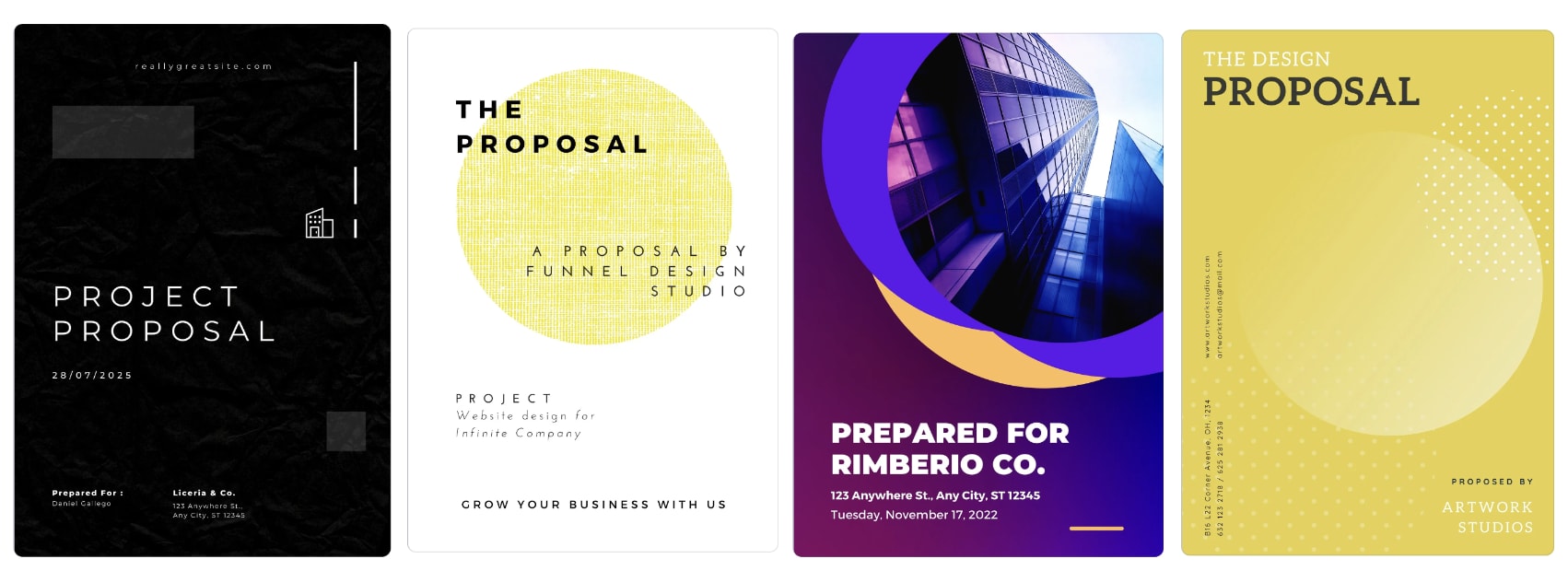11 Key Elements Of A Graphic Design Proposal for 2024 (+ Template)
What separates a good graphic design proposal from a winning one? Let’s explore the essential elements of an effective proposal that will impress potential clients and boost your win rate.
 July 20, 2023
July 20, 2023 12 minute reading
12 minute reading
Most creatives would rather focus on their craft—designing client pieces, making regular edits or redos, and honing their skills—not on sales or client acquisition.
But having the best design chops and advertising your services won’t guarantee you work. You need to convince potential clients that you understand their needs and their business, and that you’re the right person for the job.
With an effective graphic design proposal, you can sell your value proposition, delight a prospect, and potentially gain their business.
This guide explores the key components of a winning design proposal that must be present to boost your chances of success.
What is a graphic design proposal?

Source: Pexels
A graphic design proposal is a formal document that highlights a designer’s value propositions to impress or persuade potential clients and win their business.
Design proposals serve several purposes, including:
Describing the problem at hand and offering possible solutions
Painting a vision (ideas, strategies, and plans) of the success of a project
Outlining a clear process of how to achieve the project goal and vision
Setting clear project expectations/boundaries
Emphasizing your value proposition
Clarifying ownership and payment terms
Following an initial kickoff meeting with a potential client discussing project objectives, you’ll create and send them a well-crafted proposal with your proposed solution, key deliverables, time frame, and budget.
Let’s take a deeper dive into each element of a winning graphic design proposal.
Elements of a winning graphic design proposal
Prepping a graphic design proposal that will land high-value clients takes a lot more than putting together a short list of features, estimated timeline, and costs.
While each design will be different, most proposals follow the same simple format and share some essential elements.
Here’s what to include in your proposal to secure clients and land new projects.
1. Cover page

Source: Canva
A well-designed cover page makes a striking first impression and convinces a potential client of your professionalism. It also helps your proposal stand out from the crowd.
Besides adding creative designs to the cover page to make it your own, ensure it creates curiosity and convinces your reader to peruse and consider your proposition.
Add relevant details such as:
Your name
Organization name (and business logo—if available)
Title of the proposal
Name of the potential client
Submission date
2. Executive summary
The executive summary acts like a graphic design brief or general description of the contents of your proposal.
Here, you’ll share the important points in the document and compel the prospect to keep reading. This page should also convince prospects they need your services and highlights how you can meet their business needs.
The executive summary page should outline:
The problem you plan to solve
Your proposed solution to the problem
The impact your solution will have
Address these points briefly in up to three paragraphs—depending on the complexity of the project—as you’ll flesh them out later in the proposal.
Keep it short and sweet. Create an engaging and aspirational proposal that gives a potential client lots of reasons to want to work with you. Don’t overwhelm or bore your prospect with too much information. Use a visually appealing background and make the text pop to ensure the page is eye-catching.
Not sure how to write a powerful executive summary? Hire one of Fiverr’s writing experts to create concise copy that will convince readers why they need your services (learn more in our guide on how to find a ghostwriter for hire).
3. Company overview
Give a brief background about yourself and/or your company, informing prospects about:
The history of your firm
The company’s vision and mission
Your (or your team’s) skills and experience
The services you offer
The target audience you serve
Your track record working with other notable clients
Here’s an example of what you can write in this section of your proposal:

Source: Canva
4. Team members
Whether you work solo or with a team of designers, potential clients want to know what skills and expertise you bring. The team members’ page is a great place to showcase those skills, along with:
Team members’ names and photos: Add a clear photo of yourself. If you work with a team of designers, attach their respective names to their photos so the client knows who’s who.
Members’ roles: Let the client know who they’ll work with at each stage of the project. For instance, you can list your name and role as the team lead, among other members such as the account manager and the art director.
Member bios: Include a short, crisp blurb about yourself and each team members’ education, experience, and interests.
Here’s an example of how you can organize your team members page:

Source: Canva
5. Portfolio
This section shows prospects your capability to handle the project and create winning designs for the client.
Showcase previous work you’ve done so far as a graphic designer, especially pieces similar to what you’re pitching for. You can include:
Previous projects: Showcase works completed for clients in a similar niche or industry.
Diverse or varied deliverables: Show project deliverables from different niches, clients, industries, and business sizes you’ve handled previously.
Awards or certifications: If you’ve attained some industry/niche awards or certifications, add them to the portfolio section to prove your design capabilities.
Testimonials: Include testimonials from past or present clients to build credibility and trust.
“When hiring a graphic designer, and upon reviewing proposals, I need to see a variety of visuals,” says Shaun Connell, founder and CEO of U.S. Dictionary. “In a way, I want there to be too many examples of their work for me to review. Experience is key and really makes a difference in certain positions, like graphic designers, web developers, and more. I can feel more confident that they’ll keep up with me, pivot if changes need to be made or a strategy is switched up, and complete the job as I need it.”
6. Design process
Prospects will want to see how you handle projects from start to finish. But it’s hard to harness creativity into a predictable, linear set of steps.
The design process section in your proposal lays everything out for your client so you’re on the same page about expectations, schedules, milestones, and deadlines. And it shows the client you can break down projects into manageable components.
See how Black Bear does it:

Source: Black Bear Design
Add project milestones and timelines or estimated completion dates for each stage so the prospect can gauge the amount of time it’ll take to complete a project.
Here’s an example of how you can organize the design process section:
Phase 1—Design consultation/discovery (1–3 days): This phase includes a kick-off meeting to learn about the client’s requirements, discuss goals, know their industry and competitors, and analyze their existing design and needs.
Phase 2—Application and sketching (1–3 days): Share how you’ll frame the solution to your client’s problem and potential design concepts. Luciano Colos, founder and CEO of PitchGrade, says sketches or mockups visually represent the designer’s ideas, demonstrating their creative approach to enhance the client’s brand and their ability to think outside the box and create something unique.
Phase 3—Drafting (1–5 days): Create and visualize mock-ups of your proposed solution for approval.
Phase 4—Refinement (1–3 days): Refine and add finishing touches on the design to completion. You may include things like iterations, design slicing, and more.
Phase 5—Delivery (1 day): Hand over the final design asset to the client.
7. Deliverables
Deliverables refer to all the tangible or intangible project-related outputs you’ll submit within the scope of the project, during any of its phases. You need to agree upon deliverables with your prospect at the planning stage to set expectations and allocate the required resources.
Deliverables can be:
Internal: What you submit to your team members, such as the initial design or budget and time-tracking report.
External: What you submit to the client for review. Examples of external deliverables include the initial and final design or a progress report.
Process: Intermediate outputs that move a project forward without directly meeting a particular project requirement. Examples include an internal client onboarding checklist or an initial design project management plan for your client to review.
Product: Final outputs that directly meet project requirements and milestones. These can include a complete business card design or finished print media graphic.
“A graphic design proposal must clearly define the deliverables, and to help the client, offer these definitions in simple terms,” says Riley Beam, managing attorney at Douglas R. Beam, P.A. “Whether it is the ownership of the finished files, design concepts, number of revisions, or the specific scope of work, properly defining the deliverables helps both parties agree upon a transparent deal. These elements will also enable clients to view such a proposal as honest and well-defined.”
8. Project fees
In this section, outline the proposed project completion costs as service-based fees or as a category-based pricing chart along with the number of revisions/iterations per service or category.
You want to show value so the client focuses more on the transformation you can help them with—and less on your fees. Make sure there are no errors or typos on your proposal, as these suggest to the client you lack attention to detail.
Break down the fees section into these parts:
Scope of works: Summarize what the project will include based on your initial consultation meeting with the prospect. Add as much detail as needed about what is and what isn’t included to avoid scope creep.
Design documentation: This section accounts for a significant portion of your fees, as it’s the work you take the longest to complete. It includes your fees for concept development and design work, for which you can charge a fixed rate.
Construction: Here, you’ll include meetings and site visits with clients or sourcing trips, and mention your hourly rate per engagement or monthly retainer model based on a set number of hours.
Styling/refinement: Depending on the project size, you can break this section down to design work plus meetings and final styling/refining of the work.
Benefits: Share the perks the prospective client will get from working with you. The key is to sell a transformation. Include details about ordering policy, margins, hidden fees, and trade discounts so clients know there’s a clear value transfer.
9. Schedule and timeline
In this section, show the prospective client your estimates for when the project will begin and end, plus the time you need for each phase.
“Including some kind of visual timeline or schedule showing major milestones for the project will give the client an indication of when to expect their deliverables,” says Kirkland Gee, co-founder of Perfect Extraction. “This will ensure they have clear expectations going into the process about when they should expect each milestone.”
Set reasonable timelines with some room for troubleshooting or unexpected delays. That way, if you complete the project early, you’ll delight your client and hopefully secure more work rather than falling behind and dealing with a frustrated client.
Outline the project schedule, actions you expect the client to take, and anticipated timelines they should follow so you’re all on the same page.
10. Pricing and terms
Once your prospect is clear on your proposition, fees, and timelines, the next step is to clearly lay out the terms of engagement and pricing. This section will include:
Invoice payment terms
Fees and delays (including change request and restarting fees)
Your preferred mode of payment
Licensing of visual assets and related documentation
Terms for modifying the proposal
Acceptance by both parties to enter a contract
Give your prospect packages to choose from at different price points so clients can pick what meets their budget and still gets them the desired results.
For example, you could have a basic package with limited perks alongside a premium package with full benefits and advanced offerings. Alternatively, you may offer a fixed-fee package with add-ons or optional extras for clients who need more.
Offering packages increases the likelihood of you getting the job over the competition and maximizing your profit with clients willing to pay more for premium perks.
11. Next steps
Tell the prospect what comes next after they’ve understood your services and value proposition, costs, and project timelines.
Make this section easy for your client to know what to do to finalize a working relationship with you. Outline what they have to do to hire you, including general terms and conditions, payment terms, and when your working relationship officially begins.
Add a simple and clear call to action (CTA), such as a list of next steps to follow or calendar link for the prospect to book some time to chat.
“Define the next step in the process for a client or customer,” says Ariav Cohen, VP of marketing and sales at Proprep. “A CTA enables the client to take the next step instead of giving them more time to think over things or explore more options all over again. And it reveals your eagerness to get these formalities out of the way and begin work as quickly as possible.”
You can also add a signature section where the prospect can sign off on the proposal and instructions on where to send the down payment before work begins.
Hire assistant designers to grow your freelance design business
Tips for writing a winning graphic design proposal
Ready to get started with your proposal? Here are a few quick tips to streamline the process and ensure you get it right the first time:
Keep it short and simple to grab your prospect’s attention.
Present the proposal within 24 hours of the initial discovery call.
Summarize your understanding of the client’s pain points.
Explain the impact your solution will have and what the client stands to gain.
Dive into budget details (costs, timelines, and deliverables) upfront so the client can make a decision.
Set out milestones and success metrics so your client knows what results to expect.
Customize your proposal to the client you’re addressing.
Outline the next steps and how your prospect can accept the offer or negotiate terms.
Give the prospect a physical copy of the proposal and email a digital copy so it’s always available to you and the prospect.
Deliver a written version of the design proposal to the prospect for their review.
Use digital signatures for faster signing after acceptance.
Add an expiration date to the proposal so the client doesn’t come back after some time expecting the same price.
Get a legal expert to review the proposal to ensure all bases are covered and you won’t incur losses in the future in case of a legal contractual disagreement.
Thank the prospect for their time and let them know you look forward to working with them.
Follow up with the prospect days after presenting the proposal to see if they have any questions.
Land high-value graphic design projects
If you’re going to land that project from a promising lead, it’s important to know what to include and consider in your design proposal.
You could get one done faster with a template from the internet. But that won’t capture everything you need in a way that shows you understand the client’s pain points and needs and convinces them to pick you for the job.
The solution? Hire a proposal writing expert to do it for you.
Fiverr—a leading digital marketplace for freelance services—gives you access to expert proposal writing freelancers to help you create a winning graphic design proposal. The platform is user-friendly and provides the tools you need to manage all your freelancers, project files, and payments—for free.
Sign up to Fiverr today to work with an expert proposal writer and get prospects to say yes to your proposals.



